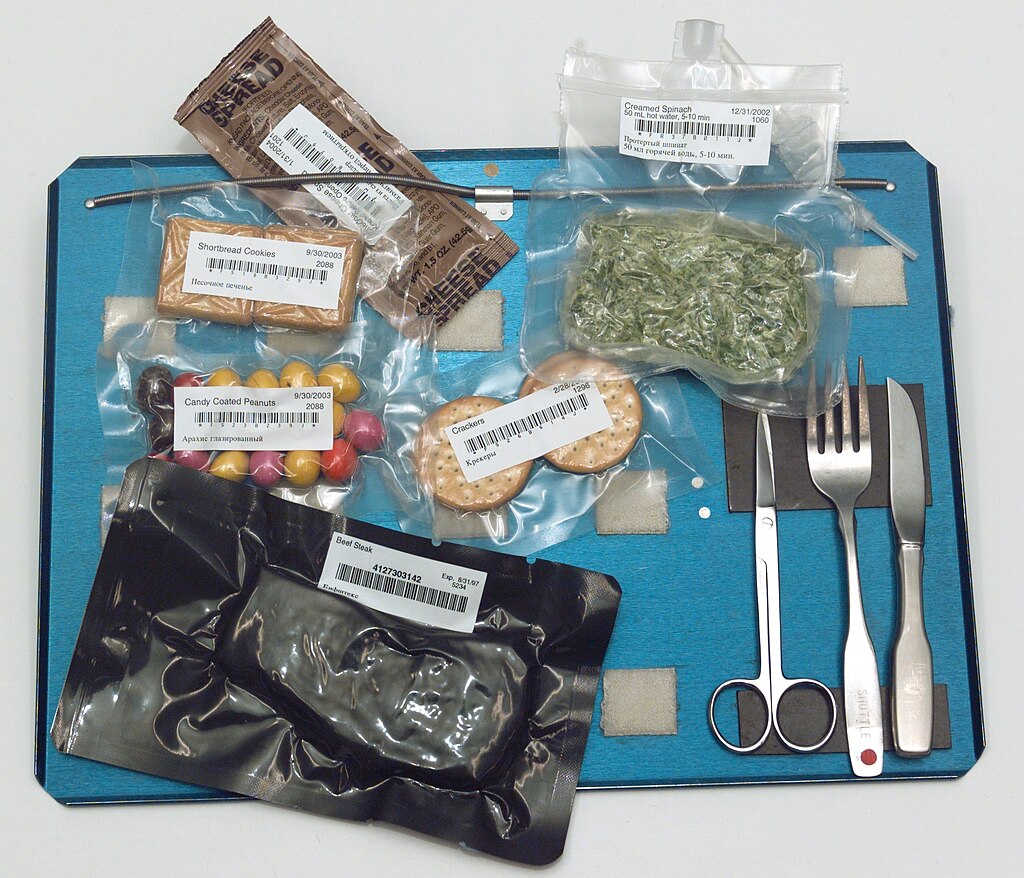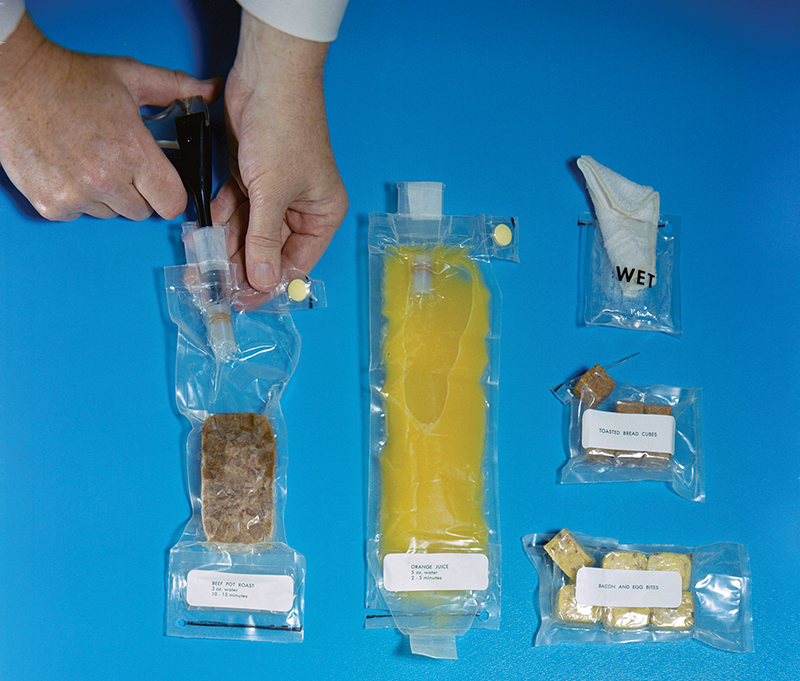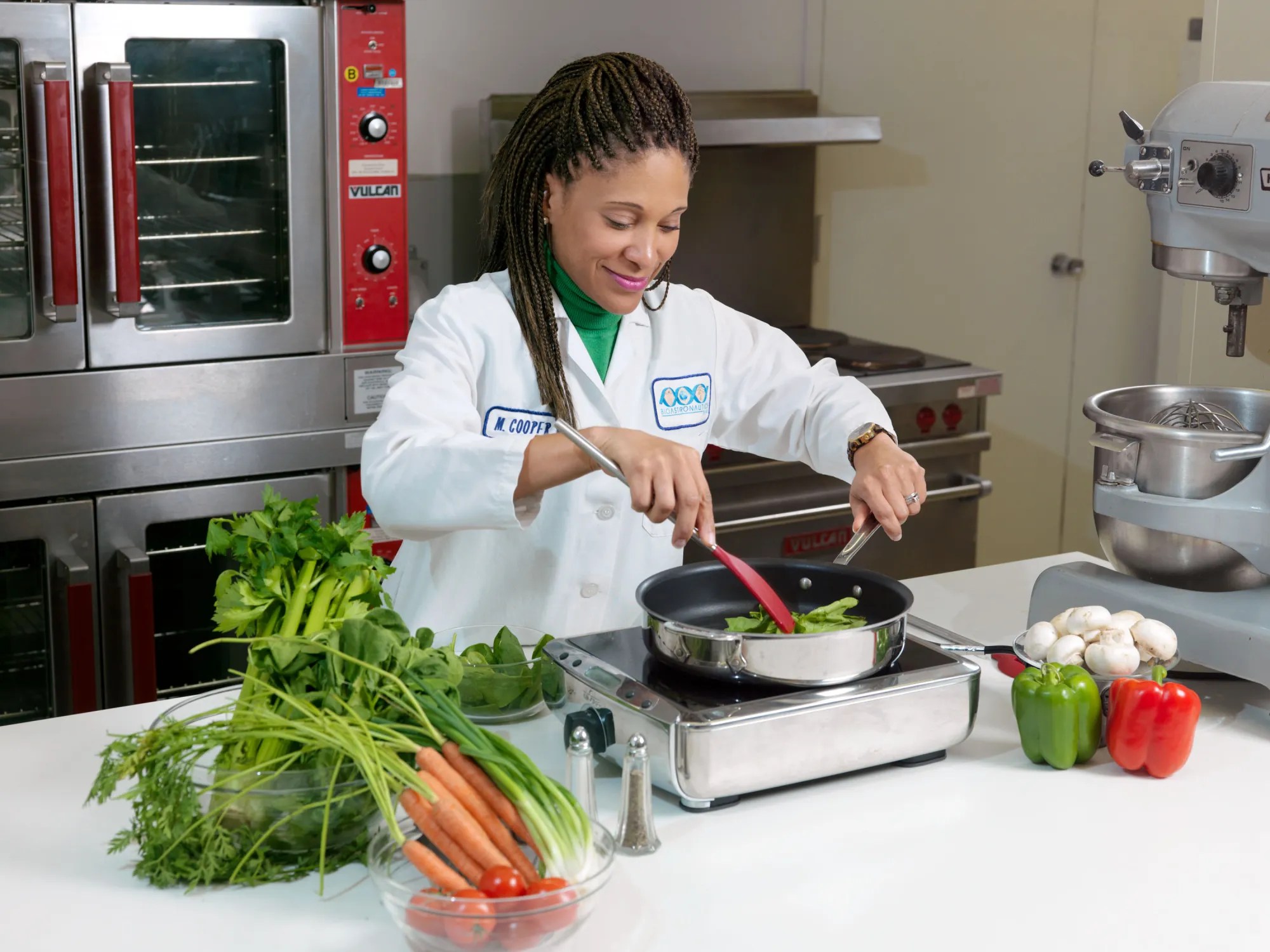Grade Level
6 - 8
subject
Engineering and Tech
stem practices
Developing and Using Models, Asking Questions and Defining Problems
Activity Type:
Engineering design challenge, STEAM, Family activity, After School Activity
This activity is part of Science Friday’s Down to Earth program.
Eating in space sounds pretty cool. You can create pizzas that “float,” drink coffee out of a specially designed cup, and choose from more than 200 foods. The menu includes American favorites, such as macaroni and cheese, chili, and a spicy shrimp cocktail, alongside cultural dishes like borscht, kung pao chicken, and sushi.
But eating on the International Space Station (ISS) can be challenging. Initially, the food came in “cubes and tubes,” which were like ready-to-eat meals that you might take camping or baby food in a squeezable package. Food needed to be lightweight, compact, and nutritious, which often meant removing water and pureeing vegetables and fruits. The food was nutritious but not very fun to eat.

Thankfully, with the help of dedicated food scientists, food in space is now tastier and more like what you might eat at home. For example, food can be rehydrated and warmed. But there are still specific considerations when it comes to food in space so that the delicate equipment isn’t damaged and the living and workspaces on board aren’t contaminated.
Making A Meal Fit For An Astronaut
Innovations For Food In Space And On Earth
Packaging food for space is extremely important. The food astronauts eat on the ISS is mostly freeze-dried. After water is added, the food can be popped into the food warmer. NASA first gave its astronauts freeze-dried food, developed in conjunction with Whirlpool and the United States Army Laboratory, during the Gemini mission, which took place from 1961 to 1966.
As the public became more fascinated with space, companies started creating their own freeze-dried foods. The public, quite literally, ate them up. So began a new way of packaging food for widespread consumption. Been on a camping trip? You’ve probably had freeze-dried food.

Food on the ISS needs to have at least a one year shelf life, so the way it’s prepared and packaged is important. Bite-sized food is placed into a sealed pouch and then given a special atmosphere technique to keep it shelf-stable. Every package is flushed with nitrogen gas at least three times before the vacuum seal is applied. This extends the food’s shelf life and prevents spoilage by ensuring there is no oxygen to degrade the food or support bacteria. Meanwhile, rehydrated food packages are thermostabilized, heated to a specific temperature to kill off any harmful microorganisms and destroy enzymes that could break down the food.
To ensure that the food the astronauts eat is safe, NASA has developed rigorous microbiological testing of its food and implemented strict checkpoints as it is processed and packaged. This testing program is so safe that it has become the standard for food safety in the U.S. Plus, these methods of safely packaging foods for extended shelf life; minimal waste; and compact, lightweight storage have made it possible to provide emergency rations in the case of disasters.
Astronaut Food Needs To Be More Than Tasty
There is a permanent ISS menu. This eight-day menu consists of three meals and one snack a day. It was designed to ensure that astronauts have a balanced diet during their stay in space. Astronauts pick the menu items for their mission five months in advance so that scientists at places like NASA’s Space Food Systems Laboratory at the Johnson Space Center can ensure that all their nutritional needs are met.

Dieticians ensure that all the menus contain between 1,900 and 3,200 calories per day, depending on the astronaut’s weight, gender, and individual needs. In space, the human body goes through many physiological changes. For example, while in space, astronauts produce fewer red blood cells, so they require less iron. Meanwhile, they get Vitamin D supplements because people usually make this nutrient when exposed to sunlight, but on the space station, astronauts are shielded from the Sun and its harmful radiation. Careful attention is given to astronaut health before, during, and after a mission.
Why Do Astronauts Eat Tortillas But Not Bread?
Some types of food work well in microgravity, while others do not. For example, one key issue with eating on the ISS is the production of crumbs. You likely don’t think much about eating and leaving crumbs here on Earth, but in microgravity crumbs can–and do–float anywhere. As a result, NASA sends tortillas to the ISS instead of bread. In this activity, you’ll investigate why!
Materials
- Mission Orbital Eats Journal
- One black napkin or black sheet of paper
- A flat surface (like a desk or a table) with a chair
- Pieces of at least two different kinds of bread, such as whole wheat, white, sourdough, French, or bagels
- At least one flour tortilla (Substitute corn tortillas, if needed.)
- A camera, like the one on your phone
- An area free of moving wind (Don’t do this near a ceiling fan or an open window.)
- A pen or pencil
- Graph paper (optional)
- A white marker or piece of chalk
NOTE: Check for wheat or gluten allergies if working with students. Substitute wheat-free or gluten-free breads and tortillas as needed.
Activity 1: Bread vs. Tortilla Challenge
- Find a desk or table that is in an area without any sort of moving air.
- Lay the black piece of paper or black napkin on your flat surface.
- Make a list of the order in which you will test each piece. You’ll need this when you’re reviewing your photos to gather your data.
- Gather your bread and tortilla.
- Sit in the chair and pick up one of the pieces of bread.
- Be sure to lean over the piece of black paper or black napkin, then take a bite of the bread.
- Check for crumbs on the piece of paper or napkin. If you don’t have any, take another bite or two.
- Once you have crumbs, take a photo of the black paper or black napkin.
- Shake the crumbs off the black paper or black napkin and repeat steps 5-8 for each of the pieces of bread and the tortilla.
- Compare the photos.
Questions to consider:
- Which type of bread left the most crumbs? Which left the least?
- Do you have a hypothesis for why that might have occurred?
- Do some research to figure out how the types of bread were made. Does your hypothesis explain why certain breads may have left more crumbs?
Discuss your results with your class, homeschool group, or family.
Activity 2: Mapping Bread vs. Tortilla Crumbs (optional)
Want to make the challenge more difficult or collect more specific data to compare the foods? Add a quantitative—something you can directly measure—element to your challenge.
- Replace the black napkin with a piece of graph paper, or draw a grid on your black paper using a white marker or piece of chalk.
- Repeat steps 3-8 from Activity 1, above.
- In addition, record where the individual crumbs landed. Mark the blocks where there are crumbs with a pencil or pen. (If you want to use the same paper several times, be sure to get a clear photo rather than marking your paper.)
- Count the number of blocks that have crumbs and record the total.
- Look at where the crumbs fell on the paper. Are there any patterns?
- Repeat for each type of bread and the tortilla. Compare your results.
Discuss your results with your class, homeschool, or family.
- Based on the data you collected, which food produced the most crumbs? How do you know? Provide evidence to support your claim.
- If desired, use additional graph paper to make a bar chart showing your results.
- You may also consider which food dispersed crumbs the furthest from the source (that’s you). Did bread send crumbs flying further than the tortilla or vice versa? What evidence supports your conclusion?
- Based on your experiment, which of the foods you tested would you suggest for use on the International Space Station? Why?
Activity 3: Beyond Bread vs. Tortilla
Try different types of food besides bread. For example, you could:
- Experiment with chips, crackers, cookies, raw vegetables, or fruit.
- Test foods from each of the five food groups: fruits, vegetables, grains, protein, and dairy.
- Get creative with your choices! Pick some of your favorite foods. How many crumbs does pizza leave behind? What about a burger?
- Make a list of foods that create crumbs and those that don’t.
- Remember, in a microgravity environment, droplets of water float just like crumbs do. How can you test for that? Could a juicy apple be as dangerous as a piece of crusty bread?
NOTE: If working with students, check for food allergies and review food packaging for potential allergens.
Design A Meal For Space
Once you have compared additional foods, use that information to develop a crumb-free menu for the ISS. Some ideas:
- Make a menu of your favorite foods.
- Research ancient food, like the Itanoni corn, and imagine how it might be used on the ISS.
- Create a menu that represents a particular culture, such as Japanese, Italian, Russian, or French.
- Consider other variables that may affect a menu on the ISS, such as packaging, storage, and nutritional needs. NASA’s Food for Spaceflight Activity has many ideas!
As you work on the challenge, consider these questions:
- Food does much more than just provide energy; it’s also a great way for people to feel at home. What comfort food would you want to have if you lived in space?
- If you were headed to Mars (which takes seven to ten months each way), do you think you’d get tired of eating the same types of food? NASA discovered that meal fatigue can lead to loss of appetite and astronauts may not get enough nutrients as a result. Do you think people on Earth feel that way about the food in their own environments? How could you combat that problem?
- It’s hard to get fresh food on the space station—and many places on Earth. That’s why NASA is working to grow food in space. What is one food you can add to your menu that you think would grow well in space?
- Try making your meal, then share it with friends or family to see. Evaluate the results. Would it make a good meal on the International Space Station? How do you know?
When you’ve planned your menu, share it! Post your filter prototype in the Down To Earth Community Lab so others can learn from your idea. Share a photo, and we’ll include it HERE for everyone to see!
Want To Learn More?
Excited by the possibilities for food science? Discover other ways this technology is changing the world!
- Learn how you could become a food scientist!
- Check out these books that talk about how astronauts eat in space:
– The Atlas Obscura Explorer’s Guide to Inventing the World by Dylan Thuras and Jennifer Swanson, illustrated by Ruby Fresson (Workman Publishing)
– How to Eat in Space by Helen Taylor, illustrated by Stevie Lewis (Little Brown BFYR)
– Spacecare: A Kid’s Guide to Surviving Space by Jennifer Swanson (Mayo Clinic Press/Smithsonian) - Find videos to watch of astronauts eating on the ISS, like Canadian astronaut Chris Hadfield’s Space Kitchen.
NGSS Standards
- MS-LS1-7: From Molecules to Organisms: Structures and Processes – Develop a model to describe how food is rearranged through chemical reactions forming new molecules that support growth and/or release energy as this matter moves through an organism.
- MS-ETS1-1: Engineering Design – Define the criteria and constraints of a design problem with sufficient precision to ensure a successful solution, taking into account relevant scientific principles and potential impacts on people and the natural environment that may limit possible solutions.
- MS-ETS1-3: Engineering Design – Analyze data from tests to determine similarities and differences among several design solutions to identify the best characteristics of each that can be combined into a new solution to better meet the criteria for success.
Career And Technical Education Career Clusters
- Agriculture: This career cluster concentrates on the scientific advancement of agriscience, cultivation, processing, and distribution of agricultural products, employing advanced technologies and sustainable practices to optimize global food systems. Plant Systems involves the study and management of plant growth, soil health, and pest management, focusing on sustainable crop production for both food and goods. Agricultural Technology & Automation sites at the intersection of agriculture and technology, focusing on the design and operation of agricultural equipment and systems.
- Hospitality, Events and Tourism: This career cluster encompasses a broad range of services and experiences related to food and beverage, lodging, travel, events, and conferences. Culinary and Food Services is dedicated to the service, operation, and management of establishments involved in the preparation and serving of food and drinks with significant emphasis on providing exceptional culinary experiences and delivering high-quality customer service.
UN Sustainable Development Goals
- Zero Hunger: Goal 2 aims to end hunger, achieve food security and improved nutrition and promote sustainable agriculture.
Credits:
Lesson by Jennifer Swanson
Developmental Editing by Sandy Roberts
Copyediting by Erica Williams
Digital Production by Sandy Roberts

Special thanks to the ISS National Laboratory and the Center for Advancement of Science in Space™ (CASIS™) for funding this resource. Working together with NASA, the ISS National Lab aims to leverage the space station to inspire the next generation.
This resource is part of Science Friday’s Down To Earth: Space Science For Community Change program.
Educator's Toolbox
Meet the Writer
About Jennifer Swanson
Jennifer Swanson is an educator, children’s book author, and the creator and cohost of the Solve It! for Kids science podcast. She’s based in Jacksonville, Florida.




